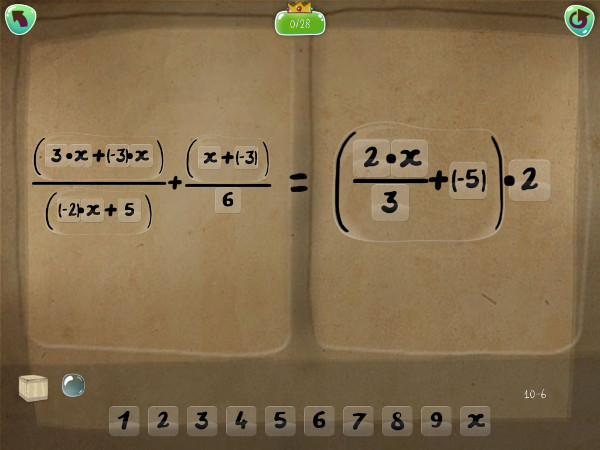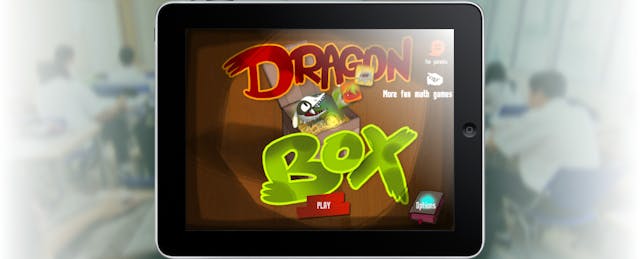Jesse Schell is, perhaps, the top educational game designer in the business right now. A few months ago I asked him what his favorite educational game was. After a brief pause, he replied, “DragonBox Algebra.”
Developed by Norwegian startup, WeWantToKnow, this game has received high praises for taking a difficult math subject (algebra) and turning it into a fun, conceptual puzzle game that can be played by kids as young as five (at least according to the company). Many parents have been thrilled to see their eight-year-old solving high school math problems on their iPad and having a great time.
The love translates into numbers. As of today, the company claims it has recorded more than 700,000 downloads.
Well, I wanted to know the secret behind WeWantToKnow’s success so I purchased the DragonBox Family Pack ($12.99), which includes DragonBox Algebra 1 and 2 (named DragonBox Algebra 5+ and 12+ in the app store), along with DragonBox Elements. I’ll only be writing about the algebra games here.
DragonBox Algebra

The DragonBox board is split into two halves, and the object is to isolate a box (which contains a baby dragon, of course) on one half of the board. You accomplish this by moving monsters and dice from one side to the other. As you do so, the monsters and dice turn from “day” versions to “night” versions. You also learn that by combining matched day and night items, they become green swirls, which can be removed from the board. As you progress, day and night become positive and negative, green swirls become zeroes, dice become integers and monsters become variables. The transition is so gradual that before you know it, you’re solving problems like this:

The game awards stars based on how efficiently you solve the puzzles. In order to achieve the maximum three stars, you must solve the problem in as few steps as possible. If I had one gripe about the DragonBox games, it would be the lack of clarity and consistency with how steps are counted. For example, in DragonBox 2, it takes three steps to subtract a variable from both sides (move a variable to the opposite side making it negative, add the negative to the positive to make a zero, cancel out the zero) but in DragonBox 1, it takes five steps (add the negative variable to each side, add the negative and positive on the left, add them on the right, remove the zero on the left, remove the zero on the right). Even if we ignore that this should really only take one step, the lack of consistency irked me.
DragonBox 1 has 100 puzzles and DragonBox 2 has 192 regular puzzles, plus 164 extra puzzles. DragonBox 2 is the better value but the content is a bit more complex than its predecessor.
When evaluating educational games, we must first ask two big questions.
1. Is it fun?
It is, but I actually think algebra is pretty fun in general. Early algebra involves a lot of “solving for X” that is, at its core, a puzzle with fairly straightforward rules and a definite solution. DragonBox is a relaxing puzzle game that never gets too difficult (Flow alert!) but will make parents think their kids are geniuses when they see the complex problems the kids appear to be solving.
2. What is the game’s learning or educational value?
Here’s where it gets tricky. DragonBox can be enjoyed by kids age 5+ and is basically algebra without arithmetic. Well, if the average American student learns arithmetic in third grade, does that mean that our kids could be solving algebra problems by fourth grade? If algebra is so simple that a five year old can get it, why do so many ninth and tenth graders have difficulty?
To answer that question, we need to go back to basics.
Arithmetic Mastery vs. Fluency
Let’s start by examining this simple algebra problem.
5x - 4 = 2x + 5
To solve for x, we must perform three arithmetic calculations: two subtractions and a division.
5x - 4 = 2x + 5
3x - 4 = 5 <— subtraction: 5x - 2x
3x = 9 <— subtraction: 5 - (-4)
x = 3 <— division: 9 / 3
Easy enough, right? Well, consider that in elementary school, solving single-digit arithmetic problems in three seconds (100 problems solved in five minutes) with 90% accuracy is generally considered mastery. Now, consider a student who has “mastered” subtraction and division and is attempting to solve the above algebra problem. In order to get the problem right, he or she would need to perform each arithmetic calculation correctly: which, at 90% accuracy for each of the three calculations, our student has a 72% chance (0.9 x 0.9 x 0.9 = 0.72) of accomplishing. And this is assuming the algebra itself is perfect. Is it any wonder so many kids hate high school math?
This phenomenon is not unique to algebra. Consider this fraction problem:
4/7 + 3/5
= 20/35 + 21/35 <— LCD, multiplication, multiplication
= 41/35 <— addition
= 1 6/35 <— subtraction
That’s five arithmetic calculations which, given 90% accuracy per calculation, results in 59% accuracy (0.9 ^ 5) for the entire problem. So between third and fifth grade, our unhappy student’s math grade plummets from an A to a dismal D- based solely on maintaining what once passed for mastery. Long division is even more severe, with a problem like (12345 / 5) requiring twelve single-digit calculations, resulting in a dreadful 28% (0.9 ^ 12) problem accuracy.
So it’s pretty clear that 90% arithmetic accuracy is nowhere near sufficient to succeed in advanced math. We should also examine the other half of mastery: speed, where three seconds per problem is generally considered mastery. Well, three seconds implies an exertion of thought and effort. Sure, it’s probably not very much effort, but when you’re solving dozens of problems with multiple calculations each, it can add up. Like attempting a conversation in a foreign language or cutting vegetables with a dull knife, minor deficiencies can make even simple tasks exhausting when performed in extreme multiples.
The arithmetic accuracy needed to succeed in advanced math is not 90%—it’s 100%. The speed needed to succeed is not three seconds per problem—it’s instantaneous (plus however long it takes to write or type the answer). Once a student reaches this upper echelon of mastery, also known as fluency, algebra, fraction arithmetic and long division transform from tedious grinds to delightfully challenging puzzles.
And that brings us back to DragonBox.
DragonBox: Algebra without the Arithmetic
Although DragonBox excels at transforming the abstract concepts and logic behind algebra into a fun, enjoyable experience, that doesn’t necessarily translate into conventional algebra proficiency. A study ( PDF ) by Carnegie Mellon researchers found DragonBox to be “ineffective in helping students acquire skills in solving algebra equations, as measured by a typical test of equation solving.” They add:
Where it falls short may be in using a concrete context to hide equations during much of the game, without a clear connection to standard algebraic notation and transformation rules…
It is not known how effective this additional instruction is. It is not that there is no learning in DragonBox – there is plenty of it, as evidenced by students’ progression through the game levels. However, the learning that happens in the game does not transfer out of the game, at least not to the standard equation solving format.
If you hand a class of third graders iPads and assign them an hour of DragonBox time, what can you expect? I’m not a teacher, but I imagine it goes something like this: DragonBox is pretty approachable so most students will enjoy it, and of those maybe half will be good at it. But how many students in the class have the A+ arithmetic fluency needed to transition from DragonBox to actual algebra? A handful? Will their teacher really want to spend the extra time to teach these top students a skill they won’t be tested on for six years?
To summarize, if a third grader...
- enjoys DragonBox
- is good at DragonBox
- has achieved arithmetic fluency
...the gap between DragonBox and good ol’ fashioned algebra is pretty small and with just little extra effort, that kid could probably be solving high school algebra equations by fourth grade. However, this transfer is NOT automatic and you should NOT expect a student to become an algebra master just by playing DragonBox.
Final Scores
Fun Factor – A: I collected all 1,366 stars available in DragonBox 1 and 2 and had a great time.
Academic Value – B: I worry that many will underestimate the effort needed to transfer DragonBox skills to practical algebra proficiency.
Educational Value – A+: Anytime a kid leaves a game with thoughts like, “algebra is fun!” or “hey, I’m really good at math!” that is a huge win.


